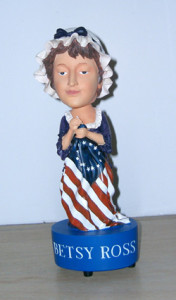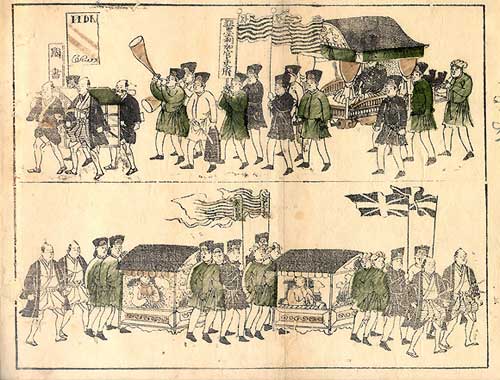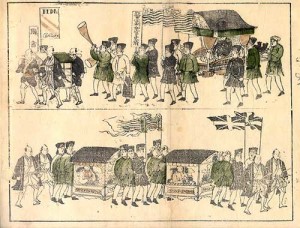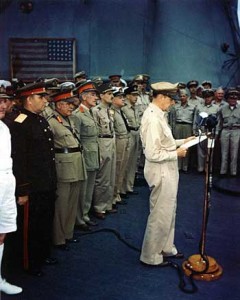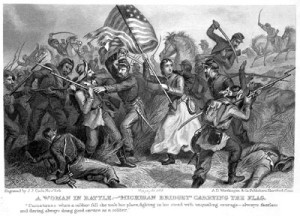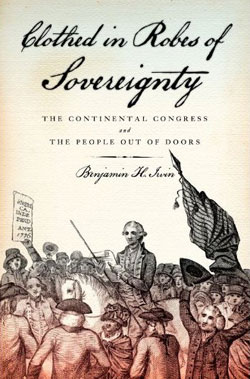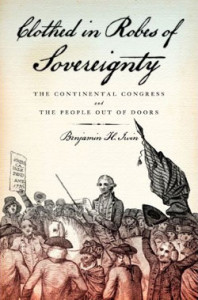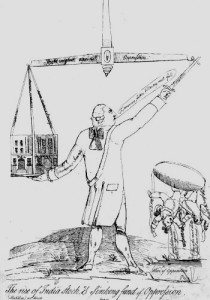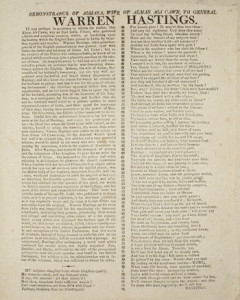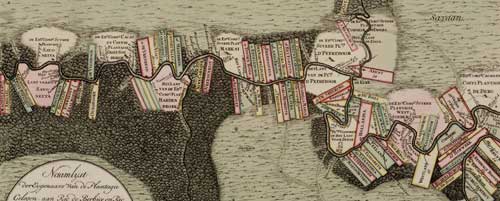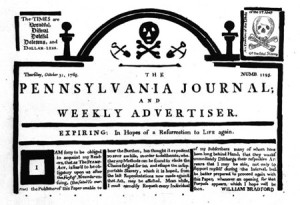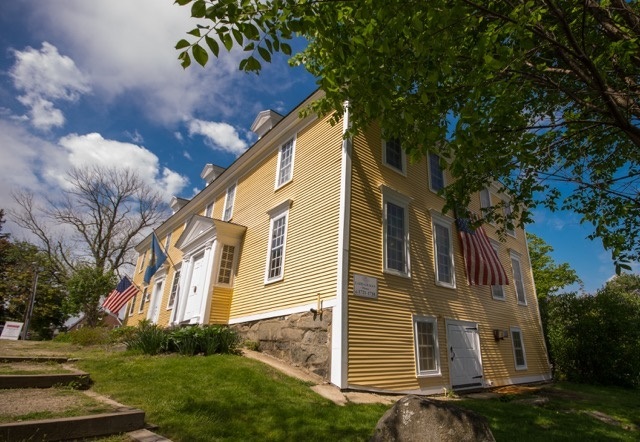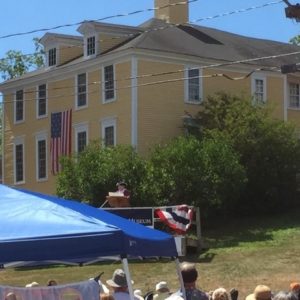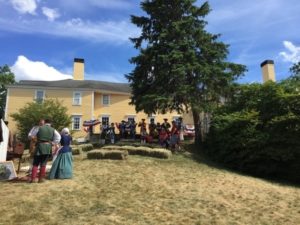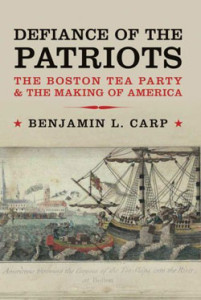How Betsy Ross Became Famous
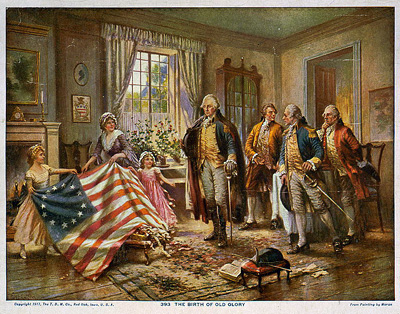
For scholars, the story of how Betsy Ross made the first American flag is about as credible as Parson Weems’s fable about little George Washington cutting down the cherry tree. Yet for more than a century, it has been an established part of American education. Among the general public, it shows no signs of going away.
The story emerged in the last third of the nineteenth century as the United States was redefining itself after the Civil War. In 1870, Ross’s grandson, William J. Canby, read a paper before the Historical Society of Pennsylvania in which he claimed that in June of 1776, George Washington and two other members of the Continental Congress visited his grandmother in her shop on Arch Street in Philadelphia. The men, according to Canby, brought a rough sketch of a striped flag with thirteen stars in a blue field. The stars had six points. Having a better idea, Ross folded a piece of paper into neat triangles, and “with a single clip of the scissors” produced a five-pointed star. Within days, she had completed the first American flag.
To the general public, details about the flag are unimportant. It is Betsy they care about.
Unable to find documents supporting his tale, Canby secured affidavits from aged relatives. These confirmed the details just as he had told them. From the first, scholars were skeptical. George Henry Preble included Canby’s account (along with virtually every other scrap of oral tradition that came his way) in his detailed and carefully documented 1872 history of the flag. But he was blunt about Canby’s credibility. For him, as for most historians, the problem was chronology. “Mr. Canby contends that the stars and stripes were in common if not general use soon after the Declaration of Independence, nearly a year before the resolution of Congress proclaiming them the flag of the United States of America; but I cannot agree with him.” Writing in 1908, John Fow dismissed the Betsy Ross legend as “ridiculous.” A 1942 history catalogued it under “More Fictions and Myths.” In the 1950s David Eggenberg concluded that the “grand total of provable facts in the Betsy Ross legend” amounted to two: that Betsy was a twice-widowed patriot needlewoman of Philadelphia and that she was paid to make Pennsylvania naval flags in 1777. “Of such flimsy material are constructed the cherished legends of American history,” he wrote.
Recent studies have been less censorious but no more supportive of the story. “Historians view her role in designing and making the first American flag as another cherished myth that has its own place in American history,” writes Lonn Taylor in a 2000 Smithsonian history. David Hackett Fischer thinks Ross’s descendants misunderstood her story. Perhaps the commission wasn’t for a national flag but for a standard for Washington’s headquarters. That explanation has its own problems, as we shall see, but it has the virtue of shifting attention from Old Glory to other flags made during the Revolution.
There is really no point in arguing over who made the first flag because there wasn’t one. The stars and stripes that we know today had multiple parents and dozens of siblings. True, on June 14, 1777, the Continental Congress passed a cryptic resolution specifying that “the flag of the thirteen united States be 13 stripes alternate red and white, that the union be 13 stars, white in a blue field representing a new constellation,” but nobody specified the shape of the flag, the arrangement of the stars, or the ratio of the canton to the field. In October 1778, Benjamin Franklin and John Adams actually told the Neapolitan ambassador that “the flag of the United States of America consists of thirteen stripes, alternately red, white and blue.” Flag sheets from the 1780s and 1790s do in fact show flags with three-colored stripes. As for Betsy’s nifty five-pointed star, a Smithsonian study showed that four-, six-, and eight-pointed stars were far more common. Although Charles Wilson Peale’s 1779 painting of George Washington at Princeton shows stars in a circular arrangement on the general’s flag, the stars themselves have six points.
To the general public, details about the flag are unimportant. It is Betsy they care about. Annually, over a quarter of a million tourists visit the supposed Betsy Ross House in Philadelphia. According to its Website, “only the Liberty Bell and Independence Hall draw more visitors than the home of the adored flagmaker.” Uptight historians might quibble about details, but the Philadelphia heroine rests securely in the sanctity of public memory.
She survives because children, teachers, and publishers love her story; because her house is located near the shrines of American liberty; and because, as with so many national legends, the legend of Betsy Ross has something to do with who we Americans believe ourselves to be. Betsy and her story are endlessly deployed as exemplars of some distinctive and noble American spirit. Hence, in a 1915 account, she represents “the glorious tradition of the patient, skillful, cheerful, energetic, patriotic woman of the American Revolution.” In a 2002 story, she embodies entrepreneurial energy. With or without the flag, the author insisted, Betsy Ross deserves to be remembered because she “challenged convention as a talented businesswoman.”
For my part, I find Betsy’s actual life less interesting than her “afterlife”—her resurrection as a national heroine. Even her name is a later simplification. Born in Philadelphia in 1752, Elizabeth Griscom married John Ross in 1773 and was widowed three years later. In 1778 she married Joseph Ashburn, a merchant mariner who died in 1783 in a British prison. Her third husband and the father of her children was John Claypoole, whose surname she bore until her own death in 1836.
Were it not for her putative role in the creation of the nation’s flag, Betsy’s life would be indistinguishable from the mass of American women who lived through a war, survived widowhood, raised families, and sustained communities. Even her work as flag maker does not, in the end, set Betsy apart. The single piece of documentary evidence for her work during the Revolution—a 1777 receipt for making ship’s flags for the Pennsylvania navy—places her among a group of Philadelphia flag makers. Margaret Manning was making ships colors for Pennsylvania as early as 1775. Cornelia Bridges, who stitched flags for the state’s “Floating Battery,” preceded Ross in the official records by a full year. More visible than any of them, however, was Rebecca Young, whose name appears frequently in the quartermaster records of the Continental Army. In the 1780s, Young was not only paid for making “continental standards” but for drum cases, blankets, and uniforms. In 1781 and thereafter, she advertised in the Pennsylvania Packet that at her shop in Walnut Street she would make “All kinds of Colours, For the Army and Navy” on the “most reasonable Terms.” Young’s career is especially interesting. For she was still alive in 1813 when her daughter, Mary Pickersgill, made the flag that Francis Scott Key saw “by the dawn’s early light” and immortalized in his “Star-Spangled Banner.”
In the last years of her life, Ross was neither more nor less important than other aging women who had lived through the Revolution. That she became famous while others were forgotten exposes the interlocking power of family history, local memory, and national politics.
Betsy Ross and Oral Tradition
When debunkers pulled Paul Revere from his horse, historians enlarged his story, turning one ride into many and a single act of patriotism into a complex narrative of revolutionary activity. In like manner, historians of Plymouth used the mythical character of the First Thanksgiving to introduce a more complex narrative of migration, settlement, and cultural transformation. So far, the story of Betsy Ross has been left to the mythmakers. As a consequence, the argument over her story hasn’t moved an inch from its nineteenth-century beginnings. Now, as then, Betsy’s defenders pit the power of oral transmission against a scholarly fixation on written sources. “It is not a tradition,” Canby wrote George Preble in 1871, “it is [a] report from the lips of the principal participator in the transaction, directly told not to one or two, but a dozen or more living witnesses, of whom I myself am one, though but a little boy when I heard it.”
The semi-official Betsy Ross Website continues in the same vein. To the question, “Can Canby be trusted?” they respond, “Can Betsy Ross herself be trusted?” They argue that since Canby got his story straight from the source, the real question is, “Did Betsy, a known flagmaker, embellish the truth by saying she made the first one?” Surely Betsy, the patriotic Quaker, could not have told a lie. To the argument that “Congress did not adopt an official flag until June 1777, a full year after Betsy claimed to have made the flag,” they respond, “Congress acting within one year! Not bad.” For them, the controversy remains what it was in 1870, a quibble between those who insist upon written documents and those willing to listen to living witnesses. The authors conclude confidently, “Historians, to their credit, always want source documentation. However, in this case, the circumstantial evidence has to be weighed. We find that it overwhelmingly supports Betsy Ross as the maker of the first flag.”
They have a point. Family traditions often convey information that would otherwise be lost. It is worth remembering that until DNA testing forced them to reconsider, many scholars dismissed the family stories that identified Thomas Jefferson as the father of Sally Hemings’s children. But unlike Ross, Hemings did not become a national icon. Popular history chooses its own company. It is not enough to tell a good story. That story must be something other people want to hear.
The debate over Betsy Ross exposes the difficulty of including women in a national narrative constructed around the biographies of leading figures. To defend Betsy Ross as Everywoman means abandoning her as heroine. But what if we really paid attention to those nineteenth-century stories, listening not for what they tell us about the first flag but for what they tell us about women’s perceptions of their own history?
In the nineteenth century, ordinary women made history. They did it by telling stories, by attaching labels to family relics, by joining honorary societies, and by carrying flags at public events. Honored by their sons and daughters, they created a version of American history that broke down boundaries between the supposedly male world of war and politics and the supposedly domestic worlds of women. They did so, not by challenging women’s exclusion from politics, but by elevating their devotion to the state.
Listen to eighty-two-year-old Rachel Fletcher telling her story to William Canby in 1870: “I remember having heard my mother, Elizabeth Claypoole, say frequently that she, with her own hands (while she was the widow of John Ross), made the first Star-Spangled Banner that ever was made.” That Fletcher called the flag a “star-spangled banner” situates it in her lifetime rather than her mother’s. Although published in 1814, Francis Scott Key’s poem entered into public consciousness during the Whig campaigns of the 1840s. During the Civil War, the flag it celebrated became synonymous with the Union.
Fletcher described an intimate and detailed collaboration between her mother and Washington. When Ross recommended five-pointed stars, “General Washington very respectfully considered her suggestions and acted upon them.” Sitting down at her table, he “altered the drawing and then made a new one according to the suggestions of my mother.” Fletcher admitted that her mother had little experience in flag making. Previously, she had been engaged in making General Washington’s ruffles. When a member of the supposed congressional flag committee, “a shipping merchant at the wharf,” invited her to call upon him, she was “punctual to her appointment.” He took an old ship’s color out of his chest, loaning it to her “to show her how the sewing was done, and also gave her the drawing finished according to her suggestions.” Since the single record documenting Ross’s work as a flag maker refers to ship’s colors, this detail is highly suggestive, but Fletcher connected it to a larger narrative focusing on the “first flag.”
She claimed that “other designs had also been made by the committee and given to other seamstresses to make, but that they were not approved.” When Ross carried “the first Star Spangled Banner that ever was made, to her employers,” it was “run up to the peak of one of the vessels belonging to one of the committee then lying at the wharf, and was received with shouts of applause by the few bystanders who happened to be looking on.” Even this validation was not enough. The committee carried the flag on the very same day “into the Congress, sitting in the State House, and made a report, presenting the flag with the drawing.” The next day, one of the committee members called on Ross and told her “that her work had been approved and her flag adopted; and he gave orders for the purchase of all the materials, and the manufacture of as many flags as she could make . . . from that time forward, for over fifty years, she continued to make flags for the United States Government.”
In her application to the Daughters of the American Revolution, a great-granddaughter went even further. After telling the story about the insistence on a five-pointed star, she noted that her ancestor was also responsible for maintaining the shape of the flag. She said that before leaving Ross’s house, a member of the congressional committee said that if more states were added to the union, more stripes would also have to be added. “Pardon me,” Betsy responded, “more stripes will spoil the symmetry of your flag. Let the symbolic thirteen stripes remain, but for each additional State let a new star shine upon the blue—there is room.” At first, the men “held their own idea the better one and added stripes until nineteen, I believe, were added; then they began to realize that they were spoiling the flag and so went back to the original thirteen.” Once again the wisdom of the venerable ancestor prevailed.
The central themes in nineteenth-century stories about Betsy Ross reflect the preoccupations of other contemporary writings about women in the Revolutionary era. Elizabeth Ellet, for example, not only emphasized the resourcefulness and sturdy patriotism of American women, but also the approbation of men in high places. By the 1870s there were hundreds of such stories about the contributions of women to the American Revolution. Among these, were many claims about a “first flag.” In his 1872 history, George Henry Preble included a story given to him by “Miss Sarah Smith Stafford,” who received it “from Mrs. Patrick Hayes, who had it from her aunt, Miss Sarah Austin,” who claimed that she and several “patriotic ladies of Philadelphia met at Swedes’ Church in that city, and under the direction of John Brown, Esq., secretary of the new Board of Marine, formed or arranged a flag,” which they presented to John Paul Jones, the hero of the American navy. Again the punch line of the story was the public display and acknowledgement of the gift. “Captain Jones was so delighted and enthusiastic, that after the presentation he procured a small boat, and, unfurling the flag, sailed up and down the river before Philadelphia, showing it to thousands on shore.” In a footnote, Preble commented dryly, “I can find no notice of this event in the church records or in the newspapers of the time.”
Stories about Jones’s flags proliferated. By 1900, the captain’s least-reliable biographer was asserting that the “unconquered and unstricken flag” that went down with the Bon Homme Richard in Jones’s famous battle with the British warship Serapis had been made at a “quilting party” in Portsmouth, New Hampshire, from “slices” of women’s silk gowns. The white stripes came from “the bridal-dress” of a woman married to “a young officer in the New Hampshire line.” There are other stories about banners constructed from fragments of clothing. The most famous has to do with the display of an improvised flag flown at Fort Schuyler after the defeat of Burgoyne in 1777. One version says that the men of the fort stitched the flag, using strips of white cut from “ammunition shirts,” blue from an enemy cloak, and red from “different pieces of stuff procured from one and another of the garrison.” Another claims that the “ladies of the settlement and the wives of some of the American officers” made the flag from “their flannel petticoats, etc.”

Stories about American women sacrificing their own food, clothing, and bedding to supply the army had been a staple of antebellum narratives. In 1889, Benson Lossing reprinted a story he had originally published in 1850 describing a visit to Mrs. Anna Bailey, an aged Connecticut woman “familiarly known as ‘Mother Bailey,'” who recalled the British assault on Fort Griswold (led by the traitorous Benedict Arnold). “I saw the American flag that was flying over the southwest bastion shot down,” she recalled. This recollection turned her thoughts to the attack on New London during the War of 1812. She told Lossing that when one of the men at the fort came to her house in Groton seeking flannel for cannon cartridges, she “started out and collected all the little petticoats of children that she could find.” When he told her that was “not half enough,” she cut the string of her own petticoat and gave it to him. “It was a heavy new one, but I didn’t care for that,” the old lady told Lossing. “All I wanted was to see it go through the Englishmen’s insides!” The men at the fort said it was a shame to cut up such a petticoat. They would rather see it “fluttering at the mast-head” of a ship, “as an ensign under which to fight upon the broad ocean!” Lossing concluded, “This and other circumstances make Mrs. Bailey a woman of history.”
In the first half of the nineteenth century, Americans had been largely indifferent to flags. Those that survived moths and time were often cut up for souvenirs. But in the decades following the Civil War, the flag and its history became compelling topics. Old ladies not only told stories, they preserved and displayed the ragged remnants of flags they believed had been used in the Revolution, The Old-Time Farm House exhibit at the Philadelphia Centennial in 1876 included two Massachusetts squadron flags as well as powder horns, a cocked hat, a canteen, a pair of spurs, and a pistol. This was without question a “women’s exhibit,” yet it included war memorabilia alongside spinning wheels and cradles. In August 1877, five granddaughters of General John Stark carried “many personal relics intimately associated with their famous ancestor” to the Centennial of the Battle of Bennington. Among them was a canton of blue silk “much faded and cracked” with thirteen five-pointed stars painted on it. In 1927, the general’s great-great-granddaughter Jennie Osborne provided the Bennington Museum with an affidavit describing the flag and its descent from mother to daughters. “Since 1910 it has been in my possession,” she wrote, explaining that she kept it in her safe deposit box at the bank. “I have never examined it carefully until lately as I have had a feeling that it was very sacred and should be taken out only on special occasions.”
Ironically, Betsy’s story may have survived because there was no actual flag to confirm or undermine it. In contrast, the flag Mary Pickersgill made for Fort McHenry survives in all its tattered glory, though the story of its manufacture is little known. When Pickersgill’s daughter Caroline Purdy heard that the flag that inspired the National Anthem was going to be exhibited in Philadelphia in 1876, she wrote Georgianna Appleton, who had inherited the flag from her father, George Armistead, the commander at Fort McHenry during the War of 1812. “I take the liberty to send you a few particulars about the ‘Flag,'” she wrote. “It was made by my mother, Mrs. Mary Pickersgill, and I assisted her. My grandmother, Rebecca Young made the first flag of the Revolution, (under General Washington’s direction) and for this reason my mother was selected by Commo. Barney and George Stricker (family connections), to make this ‘Star-Spangled Banner’ which she did, being an exceedingly patriotic woman.”
The themes in Purdy’s story are much like those in other nineteenth-century flag stories. She emphasized her mother’s work ethic and skill and the approbation of the men who commissioned the flag. The result of her mother’s labors, she believed, had four hundred yards of bunting, and her mother had “worked many nights until 12 o’clock to complete it in the given time.” The flag was so big Pickersgill had to get permissions from a nearby brewery to lay it out in their malt house. Purdy, who was then thirteen years old, assisted in the work. She remembered seeing her mother “down on the floor placing the stars,” and she insisted on “topping it” herself to make sure that in the heat of battle it would not be “torn away by balls.” History confirmed the wisdom of her decision. The flag survived, not only because of the bravery of the fort’s defenders but also because of her secure stitching. The commander of the fort was so pleased that he “declared that no one but the maker of the flag should mend it, and requested the rents be merely bound round” as a memorial to the fort’s night of glory.
No one questioned Purdy’s claim that her mother made the star-spangled banner, but the comment that her grandmother, Rebecca Young, “made the first flag of the Revolution” caused some confusion. In 1894, a New York Times article on Fort McHenry said that “Mrs. Mary Pickersgill, who forty-seven years later made the flag in Baltimore that inspired Key’s lines, was the daughter of Betsy Ross, whose work from the design of Gen. Washington was adopted by Congress.” So it was that Betsy Ross became famous and Rebecca Young and her daughter were forgotten. One could argue that Young was simply unlucky in leaving so few descendants willing to press her case. Or perhaps the stories she told her children were less dramatic, less insistent.
To appreciate the triumph of Betsy Ross, we need to appreciate how many stories women told in the decades after the Revolution. Historians are now beginning to recapture this lost archive, a repository of oral tradition that, like the slave stories gathered by the WPA, offers a complex mixture of history and memory. As Carol Berkin has written, “These stories of Revolutionary War heroines reveal surprising humor and resourcefulness. In them, young girls chew and swallow documents rather than have them discovered by the enemy; middle-aged women listen at keyholes to spy on military planning sessions; and old women serve liquor to soldiers and rob them of their guns.” To use such material requires much sifting, much sorting, and more sophisticated analysis than most scholars have yet undertaken.
Betsy Ross and Veneration of the Flag
In 1989, Michael Frisch tried a now famous experiment with students in his introductory American history course. At the beginning of the semester, he gave them a simple test. Part one asked them to write down the first ten names that came to their minds at the prompt, “American history from the beginning to the Civil War.” Not surprisingly, George Washington topped the list, followed by Abraham Lincoln, Thomas Jefferson, and other national heroes. Then he asked them to do the same thing again, this time excluding “presidents, generals, and statesmen.” In seven out of eight years, Betsy Ross was number one. The year he neglected to exclude “statesman,” she came in second to Benjamin Franklin. No other woman came close. When I tried the same experiment in the early 1990s with my own students at the University of New Hampshire, I got almost identical results.
Frisch argues that Betsy Ross endures because of her association with our “most inclusive symbol of national identity,” the flag. If George Washington is the father of the country “then surely Betsy Ross exists symbolically as the mother, who gives birth to our collective symbol.” Indeed, in America’s “civil religion” she occupies very much the position of the Virgin Mary in the Christian story. In the classic version of the Ross legend, as in the biblical story of Mary, an ordinary woman “is visited by a distant god, and commanded to be the vehicle, through their collaboration, of a divine creation. And indeed, in the classroom pageants enacted by generations of American schoolchildren over the past century, that is exactly what we see: Washington calls on the humble seamstress Betsy Ross in her tiny home and asks her if she will make the nation’s flag, to his design. And Betsy promptly brings forth—from her lap!—the flag, the nation itself, and the promise of freedom and natural rights for all mankind.”
If the religious symbolism seems far-fetched, consider an 1892 painting by Charles Weisgerber, still featured on the Betsy Ross House Website. The flag maker sits with the flag in her lap as streams of light enter from an open window linking her to the three bewigged men on the other side of the room. This is not just a patriotic illustration. It is an Annunciation.
To understand the power of the Betsy Ross story, we need to consider the historical circumstances that transformed a fragment of personal and family history into a quasi-religious epiphany. When Canby read his paper before the Pennsylvania Historical Society, the nation had just emerged from civil war and was preparing to celebrate its centennial. At the time, there were several competing ways of representing the place of women in the American Revolution. Among them was the cluster of associations embodied in the iconic Goddess of Liberty.
In the Revolutionary era, engravers pictured Liberty with a floppy cap perched on the end of a pole. These symbols derived from an ancient Roman ceremony in which a slave about to be freed was touched with a rod (the vindicata) and given a soft hat or pileus symbolizing free status. After abolitionists adopted her, the Goddess of Liberty became politically controversial. The original sketch for the statue on the dome of the United States Capitol featured the goddess with her Phrygian cap, but when the cabinet member responsible for overseeing the project objected, the designer obediently removed it. Jefferson Davis insisted that the ancient symbolism of the freed slave was “inappropriate to a people who were born free and would not be enslaved.” In 1870, a socialist uprising in Paris added a new layer of radicalism to Liberty’s cap. In May of 1871, Harper’s Weekly dismissed the women of the Paris Commune as “ten times more cruel and unreasonable than the men.” An accompanying illustration showed a crowd of “female avengers . . . with a high priestess in the middle crowned with the orthodox red cap of Liberty.
Meanwhile, noisy activists were disrupting America’s own civic ceremonies. On July 4, 1876, Susan B. Anthony and three of her compatriots interrupted the all-male program at Independence Hall by walking down the aisle and presenting a women’s “Declaration of Rights” that accused the nation of violating its own Constitution by denying women the right of trial by jury and by taxing them while denying them representation. When a much tamed Statue of Liberty was finally dedicated in New York harbor in 1886, Lillie Devereaux Blake, one of the women who had joined Anthony in Philadelphia ten years before, chartered a boat for two hundred members of the New York Women’s Suffrage Association. As the New York Times reported, “Immediately after the veil had been drawn from before Liberty’s face Mrs. Blake called an indignation meeting on the lower deck. After denouncing the ceremonies just witnessed as a farce she offered resolutions declaring ‘that in erecting a statue of Liberty embodied as a woman in a land where no woman has political liberty men have shown a delightful inconsistency which excites the wonder and admiration of the opposite sex.'”
In contrast to Liberty, Betsy Ross excited little controversy. She appeared to affirm both the nation’s devotion to freedom and the power of white women to shape history.
Weisgerber’s painting, seen by millions of visitors to the Chicago World’s Fair, thus reinforced a growing movement to venerate Betsy Ross and the flag. There were many forces at work: expanding immigration, the creation of new patriotic honor societies, contentious political campaigns, the threat of European socialism, and the triumph of United States military actions abroad. Together they fed the desire for a single, compelling national symbol—and an equally compelling story to go with it.
On Flag Day in 1894, the Pennsylvania Society of the Colonial Dames of America gathered five hundred schoolchildren at a ceremony honoring “the adoption by Congress . . . of the flag made by Betsy Ross from the design submitted to her by Gen. Washington.” The flag-veneration movement and the Betsy Ross legend grew together. By 1895, ten states had passed laws requiring public schools to display the flag on ordinary days as well as on holidays. In 1897, the New York City public schools ordered thousands of copies of Weisgerber’s painting. As the New York Times reported, “It is thought that the representation which is declared historically correct, together with such lectures as the teachers may deliver, will add much to the pupil’s knowledge and keep alive a proper reverence for the country’s emblem.”
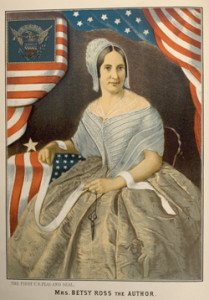
After the nation’s quick victory in the Spanish-American war, flags flew everywhere. Americans raised a one-hundred-twenty- by forty-three-foot flag over Havana in 1899, and when a victorious Admiral George Dewey returned from Manila his ship trailed a banner over five-hundred-feet long. On “Dewey Day” in St. Paul, Minnesota, in 1899, historical tableaus staged at a local church included a scene of Betsy making the first flag. On Memorial Day in Philadelphia that same year, people decorated Betsy’s grave as well as those of Union and Confederate soldiers.
In Philadelphia, veneration for the flag stimulated a movement to rescue the house on Arch Street long thought to have been Betsy’s when Washington came calling. The entrepreneurial Weisgerber, a charter member of the American Flag House and Betsy Ross Memorial Association, launched a national campaign targeted in part at schoolchildren. For ten cents, contributors received a lithographed certificate and a copy of his 1893 picture. The Ross Memorial Association claimed that over two million persons, many of them children, contributed to the restoration.
Weisgerber lived in the Flag House with his family until 1932, supporting himself in part by selling souvenirs. He even christened a son Vexil Domus, Latin for “home of the flag.” Visitors to the house had the pleasure of hearing little Vexil declaim the speeches of Patrick Henry, Nathan Hale, and other patriots as he stood on the shop counter. In 1937, an enlarged house, refurbished with a grant from Philadelphia businessman A. Atwater Kent, opened to the public. In 1941, the Betsy Ross Association deeded the house to the city of Philadelphia.
By the turn of the twentieth century, an association with Betsy Ross was almost as good as a meeting with George Washington. In 1900, a New Haven journal published Katharine Prescott Bennett’s recollections of stories that an aged relative had told her about their ancestor Rebecca Sherman, the wife of Connecticut’s representative to the Continental Congress. The old woman claimed that when “George Washington designed and ordered the new flag to be made by Betsy Ross, nothing would satisfy Aunt Rebecca but to go and see it in the works, and there she had the privilege of sewing some of the stars on the very first flag of the young Nation. Perhaps because of this experience, she was chosen and requested to make the first flag ever made in the state of Connecticut—which she did, assisted by Mrs. Wooster. This fact is officially recorded.” The story not only linked Sherman with Ross. It used that association to justify and explain the woman’s own claims as a flag maker.
In 1912 Bennett’s story reappeared in a popular history of early American women. And in 2004, journalist Cokie Roberts repeated it in her book Founding Mothers: The Women Who Raised Our Nation. Roberts acknowledged that historians doubted the Betsy Ross story, but in her view Bennett’s 1900 report of a story she got from an aged aunt who got it from Sherman’s own lips was “fairly close to a contemporaneous account.”
Betsy Ross will not go away because she gives women a part in the revolutionary narrative without disrupting its heroic outlines. Our national story does indeed focus on “presidents, generals, and statesmen,” but it also demands a role for ordinary people who sustained the patriot cause. If Paul Revere is a stand-in for the common man, Betsy represents the common woman. Her story is democratic. Unlike the allegorical Liberty, she was a flesh and blood woman—an ordinary woman—who by applying her own ingenuity and skill gave our nation its flag. Or so we would like to believe. But Betsy became famous, not because of what she did or did not do in the 1770s, but because her story embodied nineteenth-century ideas about the place of women. As told by Canby, her story was patriotic yet safe from the rough and tumble of politics. In the hands of her preservers, she challenged George Washington’s design for the flag, but she did not challenge a gender division of labor that put needles in the hands of little girls and guns on the shoulders of their brothers.
The flag-veneration movement simultaneously elevated and absorbed the stories William Canby and others gathered. In their original form, these stories were fragments in a collective oral history of the American Revolution, a largely local enterprise in which groups gathered relics into museums and historical societies and preserved stories about ordinary people, stories that had both the strengths and the weaknesses of their origins in a participatory public culture. Women’s stories encompassed many themes, but they were animated by civic pride and an insistence that women, no less than men, created a new nation. In comparison with these early stories, the Betsy Ross who emerged in the late nineteenth century seems less individual, more iconic, more a product of triumphal nationalism than of a proud and locally grounded republic.
Whether she can sustain her fame for another century is uncertain. In the fall of 2004, I tried Michael Frisch’s test on two hundred Harvard students. Their responses to the first question were almost exactly the same as in New Hampshire ten years before, but when I gave them the second question, there was an audible gasp in the room. The students had no trouble identifying the Founding Fathers, but they had a hard time coming up with the name of anyone who was not a president, general, or statesman. Perhaps acknowledging my presence in the room, a few quickly wrote, “Mrs. Washington,” “Mrs. Lincoln,” and “Mrs. Adams,” but there were a lot of blanks on these papers. In the end Paul Revere came in first and Betsy Ross dropped to seventh, though the answers were so scattered, it is hard to determine significance. The debunkers may be winning, though so far there appears to be nothing to take Betsy’s place.
Further Reading:
Two short and very accessible histories of the flag are: Lonn Taylor, The Star-Spangled Banner: The Flag that Inspired the National Anthem (Washington, D.C., 2000) and Karal Ann Marling, Old Glory: Unfurling History (Boston and London, 2004). Longer studies include: William Rea Furlong and Byron McCandless, So Proudly We Hail: The History of the United States Flag (Washington, D.C., 1981); Michael Frisch, A Shared Authority: Essays on the Craft and Meaning of Oral and Public History (Albany, N.Y., 1990); Robert Justin Goldstein, Saving ‘Old Glory’: The History of the American Flag Desecration Controversy (Boulder, San Francisco, and Oxford, 1995).
This article originally appeared in issue 8.1 (October, 2007).
Laurel Thatcher Ulrich teaches history at Harvard University. Her latest book is Well-behaved Women Seldom Make History (2007).
